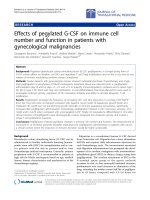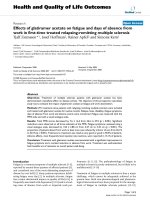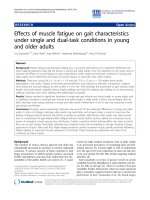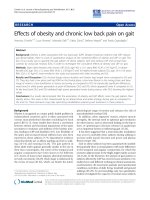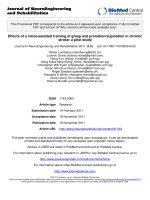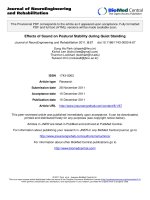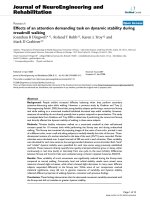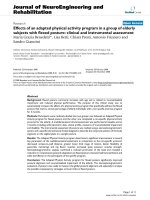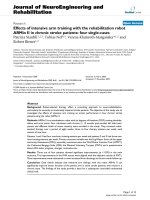báo cáo hóa học:" Effects of hip joint position and intra-capsular volume on hip joint intra-capsular pressure: a human cadaveric model" pdf
Bạn đang xem bản rút gọn của tài liệu. Xem và tải ngay bản đầy đủ của tài liệu tại đây (485.3 KB, 6 trang )
BioMed Central
Page 1 of 6
(page number not for citation purposes)
Journal of Orthopaedic Surgery and
Research
Open Access
Research article
Effects of hip joint position and intra-capsular volume on hip joint
intra-capsular pressure: a human cadaveric model
Chi-Hung Yen
1
, Hon-Bong Leung*
2
and Paul Yun-Tin Tse
1
Address:
1
Department of Orthopaedics and Traumatology, Kwong Wah Hospital, 25 Waterloo Road, Yaumatei, The Hong Kong Special
Administrative Region and
2
Department of Orthopaedics and Traumatology, Queen Mary Hospital, Pokfulam, The Hong Kong Special
Administrative Region
Email: Chi-Hung Yen - ; Hon-Bong Leung* - ; Paul Yun-Tin Tse -
* Corresponding author
Abstract
Background: Increase in hip intra-capsular pressure has been implicated in various hip
pathologies, such as avascular necrosis complicating undisplaced femoral neck fracture. Our study
aimed at documenting the relationship between intra-capsular volume and pressure in various hip
positions.
Methods: Fifty-two cadaveric hips were studied. An electronic pressure-monitoring catheter
recorded the intra-capsular hip pressure after each instillation of 2 ml of normal saline and in six
hip positions.
Results: In neutral hip position, the control position for investigation, intra-capsular pressure
remained unchanged when its content was below 10 ml. Thereafter, it increased exponentially.
When the intra-capsular volume was 12 ml, full abduction produced a 2.1-fold increase (p = 0.028)
of the intra-capsular hip joint pressure; full external rotation and full internal rotation increased the
pressure by at least 4-fold (p < 0.001). Conversely, there was a 19% (p = 0.046) and 81% (p = 0.021)
decrease in intra-capsular hip joint pressure with flexion of the hip joint to 90-degree and 45-
degree, respectively.
Conclusion: Intra-capsular pressure increases with its volume, but with a wide variation with
different positions. It would be appropriate to recommend that hips with haemarthrosis or effusion
should be positioned in 45-degree flexion.
Introduction
Increased intra-capsular pressure of the hip joint second-
ary to effusion or haemarthosis was recorded in various
hip pathologies, such as femoral neck fracture[1-4], tran-
sient synovitis[5-8], juvenile chronic arthritis[5], slipped
proximal femoral epiphysis[9], and in contused hips[10].
The raised pressure results in not only pain but also lim-
ited range of motion. [1,9,11] Furthermore, the accompa-
nied increase in the hip joint pressure is thought to be
important in the pathogenesis of Legg-Perthes' dis-
ease[12], and the progression of aseptic loosening of total
hip prosthesis[13]. Although it remains controversial, the
accompanied bony venous congestion might partially
account for the avascular necrosis and non-union after
femoral neck fracture. [9,10,14-16]
Schwarz first documented the rise of intra-capsular pres-
sure by instilling Ringer's solution in cadaveric hips. [17]
Published: 2 April 2009
Journal of Orthopaedic Surgery and Research 2009, 4:8 doi:10.1186/1749-799X-4-8
Received: 14 July 2008
Accepted: 2 April 2009
This article is available from: />© 2009 Yen et al; licensee BioMed Central Ltd.
This is an Open Access article distributed under the terms of the Creative Commons Attribution License ( />),
which permits unrestricted use, distribution, and reproduction in any medium, provided the original work is properly cited.
Journal of Orthopaedic Surgery and Research 2009, 4:8 />Page 2 of 6
(page number not for citation purposes)
However, his pioneered work failed in depicting the pres-
sure-volume relationship. If one can predict the intra-cap-
sular pressure by knowing its volume (e.g. by means of
ultrasound or computer tomogram), it will be clinically
important as high intra-capsular pressure might warrant
aggressive intervention.
Stromquvist recognised the intra-capsular hip pressure
would change with hip positions. [4] He suggested
patients should be nursed with their hips in semi-flexion
to lower the intra-capsular pressure. Nonetheless, since
his finding was based on patients with femoral neck frac-
ture, generalising the conclusion to other situations
should be cautious.
The primary objective of this project was to estimate the
hip pressure-volume relationship with refined methodol-
ogy, improved quality of data analysis and reporting. The
secondary objective was to investigate the effect of hip
position on the intra-capsular pressure, when the joint
was loaded with various amount of fluid.
Materials and methods
Procurement process was initiated at the time of certified
death. To guard against biohazard, only subjects without
infectious disease (Category one bodies)[18] were recruited.
All these bodies were assessed by the authors (CHY and
HBL) to ensure rigor mortis had not set in, the lower limbs of
these subjects had no clinically detectable abnormality, and
the hip joints had unimpaired passive range of movement.
For bodies that we identified to be eligible for recruitment, as
an additional measure to exclude degeneration and avascu-
lar necrosis of the hip, we approached the families to enquire
for any past complain over the hip joint by the diseased
patients. If that was negative, informed written consent was
obtained from the next of kin.
Handling of these bodies followed guidelines jointly pro-
posed by the Department of Health, the Hospital Author-
ity, and the Food and Environmental Hygiene
Department of the Government of Hong Kong. [18] All
procedures were performed inside a Biosafety Level-2
suite. Personal protection equipment such as face shields,
protective gloves and impermeable gowns were utilised
according to the recommendation made by the Center for
Disease Control and Prevention on Biosafety in Microbio-
logical and Biomedical Laboratories. [19]
The cadavers were positioned supine. The hip joints were
approached via open anterior approach. Dissection was car-
ried out lateral to the femoral neurovascular bundle. Muscles
anterior to the hip joint were retracted to expose the joint
capsule. The pressure monitor system was assembled as
shown in Figure 1. It consisted of a digital pressure monitor
set (REF 295-1) manufactured by Stryker
®
Instruments,
Michigan USA This monitor set could be self-calibrated and
the resolution of measurement was 1 mmHg over the range
of -10 to 200 mmHg. When the tip of the 18-gauge epidural
needle was positioned on the hip joint capsule, just before
puncturing the capsule, the monitor set was primed with
saline and calibration was then performed.
Under direct visualisation, the hip joint capsule was punc-
tured by the epidural needle. Muscle retraction was then
released before the entry pressure was recorded. The joint
was then aspirated dry with the volume of aspiration doc-
umented. Normal saline was instilled in 2 ml increments
and the intra-capsular pressure was recorded in six stand-
ardised hip positions in the following sequence. The neu-
tral position was obtained when the cadaver was placed
supine on a hard surface with his knees and heels rest on
the surface and his feet brought together to standardise
the degree of rotation. Additional positions included 45-
degree flexion, 90-degree flexion, full internal rotation in
zero-degree hip extension, full external rotation in zero-
degree hip extension, and lastly, full abduction in zero-
degree hip extension. After each instillation of saline or
change in hip position, we gently rocked the hip for ten
seconds so as to attain equilibrium of the intra-capsular
pressure before pressure readings were taken.
End point was reached after attaining the maximal intra-
capsular pressure in neutral hip position measurable by
the pressure monitor system, being 200 mmHg. After tak-
ing the hip through the six defined positions, no further
volume of fluid would be instilled.
Hips with haemarthrosis, turbid joint fluid and effusion (if
aspiration yielded more than 10 ml) were excluded. Those
hips with capsular tear, more than a single trial of joint punc-
ture, or dislodged epidural needle, were also excluded in
view of possible leakage. The procedure was adjourned when
there was a pool of fluid at the puncture site or a drop in pres-
sure regardless of increasing volume of saline injected. These
findings suggested leakage. All data harvested from these hip
joints with leakage were discarded from analysis, as we could
not be certain when the leakage started to occur.
The whole procedure should finish before the onset of
rigor mortis, an extra-articular constraint. It usually started
around six hours after death.
Statistical analysis was performed by SigmaStat for Win-
dows version 3.0 (SPSS Inc, Chicago, USA). Two-way
repeated measures ANOVA (Holm-Sidak pairwise com-
parison test) was used to assess the interaction between
hip position and intra-capsular volume. Overall signifi-
cant level was set at 0.05.
Results
Thirty-two Chinese cadavers, with 64 hip joints, were
recruited in the study. Their age ranged from 66 to 97
Journal of Orthopaedic Surgery and Research 2009, 4:8 />Page 3 of 6
(page number not for citation purposes)
years (mean = 84.2, standard deviation = 6.7). Twenty-
two cadavers (69.8%) were female. Their body height var-
ied from 124 to 168 cm (mean = 144.8, standard devia-
tion = 7.3) whereas body weight varied from 41 to 62 kg
(mean = 54.8, standard deviation = 4.5). The body mass
index ranged from 16.1 to 25.2 kgm
-2
(mean = 21.1,
standard deviation = 2.0).
Twelve hip joints were excluded from the study because
the epidural needles were dislodged upon releasing the
muscle retraction (8 cases), presence of a pool of saline (1
case) or a decrease in intra-capsular pressure despite
instilling further volume of saline (3 cases). Among all the
studied hips, no macroscopic capsular tear was noted. No
hips had haemarthrosis or turbid joint fluid.
The entry pressure varied from -2 to 2 mmHg. All hip
joints yielded dry aspiration.
In neutral position, the hip joint pressure started to
increase exponentially when its content exceeded 10 ml
(Figure 2). When the volume of intra-articular fluid
exceeded 4 ml, 45-degree hip flexion consistently showed
the lowest pressure (p < 0.001) and full internal rotation
in zero-degree extension yielded highest pressure (p <
0.001).
When the intra-capsular volume was 12 ml, compared to
the neutral position, full abduction produced a 2.1-fold
increase (p = 0.028) of intra-capsular hip joint pressure;
full external rotation and full internal rotation increased
the pressure by at least 4-fold (p < 0.001) (beyond meas-
urable limit of the system) (Table 1). Conversely, there
was a 19% (p = 0.046) and 81% (p = 0.021) decrease in
intra-capsular hip joint pressure with flexion of the hip
joint to 90-degree and 45-degree, respectively. At 14 ml
intra-capsular volume, the intra-capsular pressure
increased significantly. Even the hip joint was flexed to
45-degree, the mean intra-capsular volume remained
higher than 40 mmHg, a level considered as dangerously
high. [2]
Discussion
Schwarz [17] was honoured for pioneering hip pressure-
volume relationship delineation. Our cadaveric model
was based on his methodology but with a number of
modifications. For example, open anterior approach was
utilised as it was more direct, thus decreasing the chance
of needle dislodgement. This approach also allowed visu-
alisation of leakage if present. Instillation in 2 ml incre-
ment could better delineate the pressure-volume
relationship. We rocked the hip after each instillation of
fluid to equilibrate the effective hip joint cavity. Without
practising such maneuver in our pilot study, the instanta-
neous intra-capsular pressure was quite high. Increased
sample size could narrow the confidence interval. Pres-
sure was measured by a commercial pressure transducer,
which had been validated to have high accuracy. [20]
Regrettably, due to logistic reasons, the hips could not be
examined radiologically to rule out intra-articular pathol-
ogies which could significantly affect the result. We were
also unable to monitor the pressure through the range of
motion and in their combination (e.g. 45-degree flexion
with full internal rotation and abduction). Moreover, this
study suffered from a few drawbacks that limited general-
isation of data to in vivo circumstances. Firstly, in a cadaver
model, normal soft tissue tension generated by muscle
tone could not be restored. Secondly, we could not guard
against minute leakage and uneven distribution of fluid
inside the hip joint. Thirdly, weight of the leg and the
external force applied by the authors in maintaining the
defined hip position were not standardised. And since all
subjects were elderly Chinese, extrapolating the informa-
tion to younger age group and other ethnicities should be
cautious. Finally, we only elected to test six positions in
either coronal or sagittal plane. But the position that
yielded the highest and lowest pressure might locate
somewhere between the two planes, and with the degree
of rotation not tested in our study.
We would like to alert readers on interpreting the sigmoid
curve volume-pressure relationship when the hip was
positioned in full internal rotation. This finding could be
erroneous as the plateau effect was due to our limitation
The digital pressure monitor system used to measure intra-capsular pressure of cadaveric hipFigure 1
The digital pressure monitor system used to meas-
ure intra-capsular pressure of cadaveric hip. The
whole system consists of a 18-gauge 3.25-inch epidural nee-
dle (Perican
®
with Tuohy bevel, B. Braun Melsungen AG, Bra-
zil), an unyielded 54-inch connection tubing designed for
arterial line measurement, a 3-way stopcock, a 25 ml syringe,
and the Quick Pressure Monitor Set mounted inside the
Stryker Pressure Monitor (Stryker Inc, Cedex, France). The
Quick Pressure Monitor Set consists of a membrane drum,
and a 3 ml syringe. It is manufactured by the same company
as the consumable for the pressure monitor. The system was
primed with saline.
Journal of Orthopaedic Surgery and Research 2009, 4:8 />Page 4 of 6
(page number not for citation purposes)
in recording pressure higher than 200 mmHg. Further-
more, leakage might start to occur when the pressure
increased to this high level. Having said that, knowing the
exact pressure might not be of clinical importance as 200
mmHg is already well above the critical perfusion pres-
sure. [2,14] Drake et al reported a pressure of 40 mmHg
could already jeopardise the femoral head perfusion. [2]
In neutral hip position, the intra-capsular pressure
approached that critical perfusion pressure when 12 ml of
0.9% saline was instilled into the joint (Figure 2). How-
ever, in certain hip joint positions, such dangerously high
pressure was attained at a much lower intra-capsular vol-
ume. Only 6 ml, 8 ml and 10 ml was required to exceed
the critical intra-capsular pressure in full internal rotation,
full external rotation, and full abduction respectively. The
hip capsule, being reinforced by multiple ligamentous
condensations, is not elastic under physiological condi-
tion. [21-23] Internal rotation of hip particularly tighten
the ischiofemoral ligament and lateral arm of the iliofem-
oral ligament. The iliofemoral ligament of Bigelow is taut
on external rotation. [24] The ischiofemoral ligament
checkreins abduction. [25] Flexion, however, places least
tension on these non-yielding ligaments. [24]
Although the actual volume of effusion or haemarthrosis
was never known in clinical setting,[26] our finding sug-
gested a simple measure could avoid undue intra-capsular
pressure by paying respect to the hip position. Based on
our data on intra-capsular pressure with reference to the
hip positions, care should be exercised to avoid skin or
skeletal traction of the affected hip in full external or inter-
nal rotation. Provided the intra-capsular volume is less
than 12 ml, positioning the hip in 45-degree of flexion
can confer a safe intra-capsular pressure below 40 mmHg.
Clinically, this position can be simply accomplished by
resting the affected leg on two pillows or a Thomas splint
with Pearson knee attachment. For hip joint with its con-
tent estimated to be more than 14 ml, no hip position was
found to be able to attain pressure lower than the critical
perfusion level. The only way to maintain a safe level of
intra-capsule pressure will be continuous aspiration or
open drainage.
Although femoral neck fracture was not investigated in
our study, we expect the above discussion might not be
valid for displaced fracture. Drake et al reported that the
volume of blood that could be aspirated from hip with
displaced femoral neck fracture never exceeded 5 cc. [2]
Crawfurd also documented that the intra-capsular pres-
sure was higher in Garden [27] Grade I and II than in Gar-
den Grade III and IV with an average of 66.4 mmHg and
28 mmHg respectively. [1] Although no concrete explana-
tion was made, it might be in the event of displaced fem-
oral neck fracture, not only the capsule was torn but also
the intra-medullary cavity was rendered communicating
Relationship between intracapsular hip joint pressure and hip joint volume according to six standardised hip joint positionsFigure 2
Relationship between intracapsular hip joint pressure and hip joint volume according to six standardised hip
joint positions.
0
20
40
60
80
100
120
140
160
180
200
02468101214
Intra-capsular pressure (mmHg)
Volume injected (ml)
Neutral
45° flexion
90° flexion
Full internal
rotation
Full external
rotation
Full abduction
Journal of Orthopaedic Surgery and Research 2009, 4:8 />Page 5 of 6
(page number not for citation purposes)
with the joint proper. The intra-medullary venous system
can effectively drain the hemarthrosis. Before further work
is done, projecting our finding into this clinical scenario
should be cautious.
From our clinical observation, patients with hip disorders
were also commonly noted to rest their hips in flexion. No
scientific explanation had been made to account for this
apart from empirically relating it to preferential spasm of
hip flexors. In our study, we demonstrated that in this par-
ticular position of hip, the joint conferred the lowest pos-
sible pressure. Relaxing the capsular ligaments in hip
flexion could be the reason. An in vivo study might pro-
vide a better insight in this issue.
Conclusion
In neutral hip position, joint pressure remained low until
its content exceeded 10 ml. Afterwards, its pressure rose
exponentially. Position of the hip joint affected the intra-
capsular pressure. For the specific positions being tested,
full internal rotation resulted in highest pressure, fol-
lowed by full external rotation and full abduction. Forty-
five-degree hip flexion yielded lowest pressure. We recom-
mended to position hips with undisplaced femoral neck
fracture or with effusion in 45-degree flexion to ensure
low intra-capsular pressure.
Competing interests
The authors declare that they have no competing interests.
Authors' contributions
All authors had substantial contributions to conception
and design, analysis and interpretation of data, drafting
and giving final approval to the manuscript. CHY and
HBL were responsible to the acquisition of data.
Acknowledgements
Authors would like to acknowledge Dr KL Mak from the Department of
Pathology, Kwong Wah Hospital and the mortuary staff of Kwong Wah
Hospital for their support. It would be impossible to execute the study
without the great understanding of the subjects' relatives in their hardest
moment.
References
1. Crawfurd EJ, Emery RJ, Hansell DM, Phelan M, Andrews BG: Capsu-
lar distension and intracapsular pressure in subcapital frac-
tures of the femur. J Bone Joint Surg Br 1988, 70(2):195-8.
2. Drake JK, Meyers MH: Intracapsular pressure and hemarthro-
sis following femoral neck fracture. Clin Orthop 1984:172-6.
3. Holmberg S, Dalen N: Intracapsular pressure and caput circula-
tion in nondisplaced femoral neck fractures. Clin Orthop Relat
Res 1987:124-6.
4. Stromqvist B, Nilsson LT, Egund N, Thorngren KG, Wingstrand H:
Intracapsular pressures in undisplaced fractures of the fem-
oral neck. J Bone Joint Surg Br 1988, 70(2):192-4.
5. Rydholm U, Wingstrand H, Egund N, Elborg R, Forsberg L, Lidgren L:
Sonography, arthroscopy, and intracapsular pressure in
Table 1: Intracapsular hip joint pressure according to hip joint volume and hip joint position.
Intracapsular hip joint volume
0 ml 2 ml 4 ml 6 ml 8 ml 10 ml 12 ml 14 ml p-value of
ANOVA for
different joint
volume
Hip joint position
Neutral 0.0 (0.0) 1.2 (0.6) 2.3 (2.1) 3.1 (0.6) 4.1 (1.7) 7.9 (5.5) 49.8 (15.9) 137.6 (30.9) 0.00
45° flexion 1.1 (1.5) 2.7 (1.5) 2.3 (2.1) 3.7 (1.5) 4.4 (1.9) 4.7 (2.1) 9.5 (4.8) 40.7 (16.1) 0.00
90° flexion 0.9 (1.3) 2.8 (1.8) 8.7 (7.2) 9.4 (7.0) 33.0 (16.9) 36.0 (15.5) 40.6 (16.3) 94.1 (25.1) 0.00
Full internal
rotation
0.8 (1.3) 10.1 (4.8) 30.5 (42.8) 91.1 (21.5) 149.5 (34.0) 185.9 (30.5) 198.6 (10.3) 199.1 (6.7) 0.00
Full external
rotation
0.8 (1.2) 4.2 (1.9) 6.2 (7.8) 14.1 (5.6) 50.0 (24.2) 124.8 (16.5) 198.2 (13.2) 198.5 (10.7) 0.00
Full abduction 0.2 (0.9) 1.9 (1.9) 4.8 (6.5) 21.1 (11.8) 27.4 (14.6) 68.5 (19.5) 105.8 (26.4) 196.9 (7.3) 0.00
p-value of
ANOVA for
different hip
positions
0.99 0.12 0.04 0.00 0.00 0.00 0.00 0.00
Values and blankets represent the mean pressure and standard deviation respectively. Units are in mmHg.
Publish with BioMed Central and every
scientist can read your work free of charge
"BioMed Central will be the most significant development for
disseminating the results of biomedical research in our lifetime."
Sir Paul Nurse, Cancer Research UK
Your research papers will be:
available free of charge to the entire biomedical community
peer reviewed and published immediately upon acceptance
cited in PubMed and archived on PubMed Central
yours — you keep the copyright
Submit your manuscript here:
/>BioMedcentral
Journal of Orthopaedic Surgery and Research 2009, 4:8 />Page 6 of 6
(page number not for citation purposes)
juvenile chronic arthritis of the hip. Acta Orthop Scand 1986,
57(4):295-8.
6. Wingstrand H: Transient synovitis of the hip in the child. Acta
Orthop Scand 1986, 219(Suppl):1-61.
7. Wingstrand H, Egund N, Carlin NO, Forsberg L, Gustafson T, Sunden
G: Intracapsular pressure in transient synovitis of the hip.
Acta Orthop Scand 1985, 56(3):204-10.
8. Hasegawa Y, Ito H: Intracapsular pressure in hip synovitis in
children. Acta Orthop Scand 1991, 62(4):333-6.
9. Vegter J: The influence of joint posture on intra-articular pres-
sure. A study of transient synovitis and Perthes' disease. J
Bone Joint Surg Br 1987, 69(1):71-4.
10. Stromqvist B, Wingstrand H, Egund N, Carlin NO, Gustafson T, Her-
rlin K, Nilsson LT, Thorngren KG, Onnerfalt R: Traumatic hip joint
tamponade. Two cases with femoral head ischaemia. Acta
Orthop Scand 1985, 56(1):81-5.
11. Robertsson O, Wingstrand H, Onnerfalt R: Intracapsular pressure
and pain in coxarthrosis. J Arthroplasty 1995, 10(5):632-5.
12. Wingstrand H: Significance of synovitis in Legg-Calve-Perthes
disease. J Pediatr Orthop B 1999, 8(3):156-60.
13. Robertsson O, Wingstrand H, Onnerfalt R: Intracapsular pressure
and loosening of hip prostheses. Preoperative measure-
ments in 18 hips. Acta Orthop Scand 1997, 68(3):231-4.
14. Ferguson AB: Segmental vascular changes in the femoral head
in children and adults. Clin Orthop Relat Res 1985:291-8.
15. Lucht U, Bunger C, Krebs B, Hjermind J, Bulow J: Blood flow inthe
juvenile hip in relation to changes of the intraarticular pres-
sure. An experimental investigation in dogs. Acta Orthop Scand
1983, 54(2):182-7.
16. Launder WJ, Hungerford DS, Jones LH: Hemodynamics of the
femoral head. J Bone Joint Surg Am 1981,
63(3):442-8.
17. Schwarz N, Leixnering M, Hopf R, Jantsch S: Pressure-volume
ratio in human cadaver hip joints. Arch Orthop Trauma Surg 1988,
107:322-325.
18. Precautions for Handling and Disposal of Dead Bodies [http:/
/www.info.gov.hk/aids/pdf/g110.pdf]
19. Biosafety in Microbiological and Biomedical Laboratories
[ />]
20. Seiler JG 3rd, Womack S, De L'Aune WR, Whitesides TE, Hutton
WC: Intracompartmental pressure measurements in the
normal forearm. Journal of Orthopaedic Trauma 1993, 7(5):414-6.
21. Tarasevicius S, Kesteris U, Gelmanas A, Smailys A, Wingstrand H:
Intracapsular pressure and elasticity of the hip joint capsule
in osteoarthritis. J Arthroplasty 2007, 22(4):596-600.
22. Wingstrand H, Wingstrand A: Biomechanics of the hip joint cap-
sule – a mathematical model and clinical implications. Clin
Biomech (Bristol, Avon) 1997, 12(5):273-280.
23. Wingstrand H, Wingstrand A, Krantz P: Intracapsular and atmos-
pheric pressure in the dynamics and stability of the hip. A
biomechanical study. Acta Orthop Scand 1990, 61(3):231-5.
24. Martin HD, Savage A, Braly BA, Palmer IJ, Beall DP, Kelly B: The
function of the hip capsular ligaments: a quantitative report.
Arthroscopy 2008, 24(2):188-95.
25. Thiel W: Photographic atlas of practical anatomy Volume 1. New York,
Springer Company; 1997:352-365.
26. Egund N, Wingstrand H, Forsberg L, Pettersson H, Sunden G: Com-
puted tomography for diagnosis of hip-joint effusion in chil-
dren. Acta Orthop Scand 1986, 57(3):211-5.
27. Garden RS: Stability and union in subcapital fractures of the
femur. J Bone Joint Surg Br 1964, 46:630-47.
